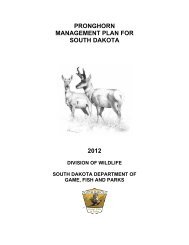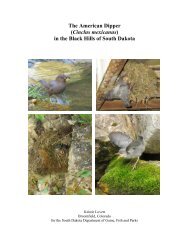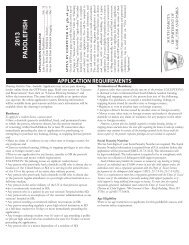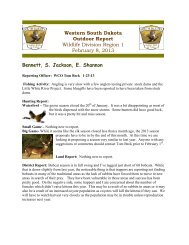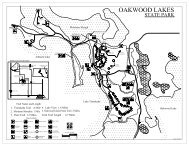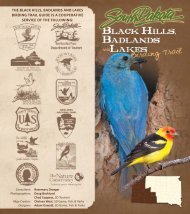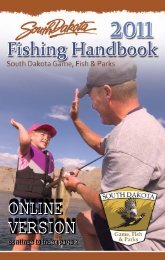pdf version - South Dakota Department of Game, Fish and Parks
pdf version - South Dakota Department of Game, Fish and Parks
pdf version - South Dakota Department of Game, Fish and Parks
Create successful ePaper yourself
Turn your PDF publications into a flip-book with our unique Google optimized e-Paper software.
Stonecat<br />
Noturus fl avus<br />
Quick key characteristics: The stonecat is found in cool- <strong>and</strong> warm-water<br />
habitats. It is scaleless with an elongated caudal fi n base that wraps around<br />
the caudal peduncle <strong>and</strong> is continuous with the low-pr<strong>of</strong>i le adipose fi n. Sharp,<br />
venomous spines are present on front edges <strong>of</strong> the dorsal <strong>and</strong> pectoral fi ns.<br />
It has a wide, frontward-facing mouth, with a relatively pointed snout <strong>and</strong><br />
upper jaw over-hanging the lower. Its body shape is relatively tubular <strong>and</strong> it<br />
has prominent snout, mouth, <strong>and</strong> chin barbels.<br />
Similar species in <strong>South</strong> <strong>Dakota</strong>: other catfi sh, especially young<br />
Identifi cation: The combination <strong>of</strong> (1) a low adipose fi n connected to the<br />
tail (caudal) fi n, (2) light-colored (cream, yellow) margins on the rounded<br />
(not forked) caudal fi n, (3) upper jaw over-hanging lower, (4) dorsal <strong>and</strong><br />
pectoral fi n spines two thirds or less <strong>of</strong> maximum fi n heights, <strong>and</strong> (5) light<br />
“saddle marks” on back immediately in front <strong>of</strong> <strong>and</strong> behind the dorsal fi n<br />
distinguishes the stonecat from similar fi shes in <strong>South</strong> <strong>Dakota</strong>.<br />
Range: The stonecat is native to northern portions <strong>of</strong> the Mississippi River<br />
basin <strong>and</strong> portions <strong>of</strong> the Great Lakes basin. In <strong>South</strong> <strong>Dakota</strong>, it is most<br />
common in larger streams <strong>and</strong> rivers, where it occupies riffl es.<br />
Items <strong>of</strong> interest:<br />
• Feeds on insects, crustaceans,<br />
molluscs, small fi shes, plants, <strong>and</strong><br />
detritus<br />
• Breeding individuals guard their eggs<br />
• Less likely to school than other<br />
catfi sh<br />
• May be captured by angling<br />
• Rarely exceeds 12 in. <strong>and</strong> 1 lb<br />
38








